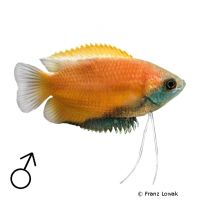Red Orange Honey Gourami (Trichogaster chuna 'Red Orange')
| Red Orange Honey Gourami Trichogaster chuna 'Red Orange' | |
|---|---|
| Name | Red Orange Honey Gourami |
| Name Lat. | Trichogaster chuna 'Red Orange' |
| Synonym | Colisa chuna |
| Family | Gouramies |
| Family lat. | Osphronemidae |
| Order | Labyrinth Fishes |
| Order lat. | Anabantiformes |
| Origin | India, Bangladesh |
| Habitat | Ponds, floodplains |
| Diet | Omnivore |
| pH | 6.0-7.5 |
| Behavior | Peaceful |
| Keeping | Pair |
| Care Level | Moderate |
| Reproduction | Bubble nest builder |
| Breeding | Moderately difficult |
| Life Span | 3-4 years |
| Protection | No |
| Metric Units | |
| Size | 5 cm |
| Temperature | 22-27 °C |
| Hardness | 2-15 °dH |
| Aquarium | ~ 60 l |
| US Units | |
| Size | 2" |
| Temperature | 72-81 °F |
| Hardness | 36-267 ppm |
| Aquarium | ~ 15 gal |
Distribution and habitat
The Rotor Orange Honey Gurami is a breeding form. Honey gourami are widespread in the lowlands of the Ganges provinces, Assam and Manipur (India), and Bangladesh. There they live in waters with dense vegetation, such as ponds, ditches, ponds and lakes, as well as rice fields and floodplains.
Maintenance
The aquarium should have dense planting with many hiding places (stones, roots). A dark substrate with foliage (sea almond leaves) and subdued light (floating plant cover) is ideal.
No ammonia, ammonium and nitrite should be detectable, the nitrate value should not exceed 100 mg/l. To ensure the water quality and oxygen content, a filter and heater adapted to the aquarium size is required, as well as lighting for the species-appropriate day-night rhythm of the animals.
Diet
The food supply consists of live, frozen and dry food. For a balanced diet, feed once a day with a high quality dry food (flakes, granules, pellets) as well as cyclops, daphnia, artemia, mosquito larvae, etc. (live or frozen). In addition, they need some vegetable food, such as algae leaves, algae wafers or dry food with high vegetable content.
It is recommended to feed small portions several times a day, which are eaten within a few minutes. A regular and varied diet promotes health and increases resistance.
Behaviour and compatibility
These peaceful fish should be kept in pairs and do well in a community tank with fish that are not too lively or peaceful. They should not be kept together with fin-clipping fish, such as Sumatran barbs or blood tetras. During the spawning season, males occasionally behave territorially among themselves
As a general rule, only mutually compatible fish species with similar water condition and water temperature requirements should be socialized.
Sex dimorphism
Adult females are brownish in color, significantly larger than males, and have a broad, brownish median stripe.
Reproduction and breeding
The male builds a loose foam nest, often on the underside of large water plant leaves, and also takes care of the brood. The eggs ejected during the numerous matings (entwinements) rise to the water surface, are collected by the male and introduced into the nest. The larvae hatch after 24-36 hours and swim freely after only 2-3 days.
The fry must be fed several times a day with special rearing food (dust food, Artemia nauplii). In a community tank breeding is hardly possible, because the fry are easy prey
Important
Honey gourami are bred in different color variations
They have an additional respiratory organ called the labyrinth (suprabranchial organ) with which they breathe atmospheric air and can suffocate if this is not possible
The thread-like elongated ventral fins are used for orientation and chemical perception (taste stimuli).
The well-being of the fish should be monitored regularly. Temperature should be checked daily, pH, hardness and nitrate levels should be checked at least every 14 days. Regular partial water changes are recommended, even if the contaminant level has not yet reached the upper limit. Sudden changes in water quality should be avoided. Newly introduced fish must be accustomed slowly to the water in the aquarium.
Further literature can be found in your pet store.
References
Text: petdata; Image: Franz Lowak
Source: BMEL (1998): Tierschutzgutachten - Haltung von Zierfischen (Süßwasser); RIEHL & BAENSCH (2006): Aquarien Atlas Bd. 1, Mergus Verlag; ENGELMANN (2005): Zootierhaltung - Tiere in menschlicher Obhut: Fische, Verlag Harri Deutsch
- Gemäß § 21 Abs. 5 Tierschutzgesetz idgF
